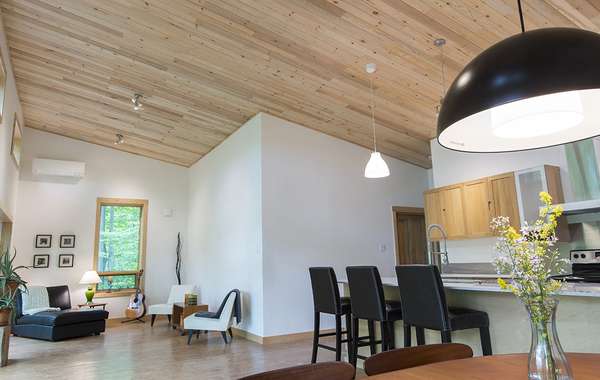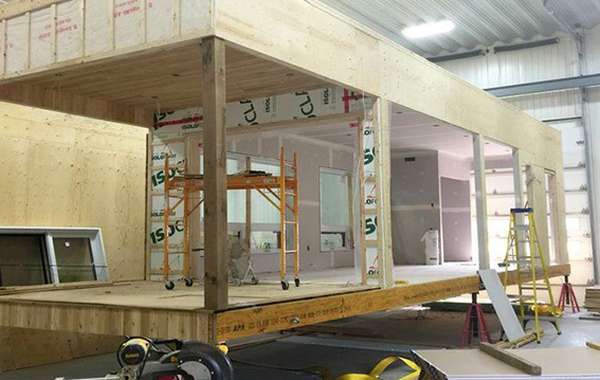Green home building with LEED for Homes
There are 8 LEED categories with a total of 136 available points, and a minimum amount is required to achieve certification. This point threshold is determined by the size of the house compared to the amount of bedrooms. To encourage increased housing density, homes with more bedrooms per total square foot have lower certification point thresholds.
Within the 8 categories there are 19 mandatory measures and a number of requirements in which each project must obtain. The more points accumulated, the more the project may exceed the "Certified" level and earn silver, gold, or platinum.
The 8 LEED categories:
Innovation & Design Process (11 points)
Green building begins at the design phase, and this category encourages builders to put together their building team early and involve them in the design process. It is here that regional issues and home durability is addressed, and building orientation is determined to maximise passive solar gains.
Locations & Linkages (10 points)
The location and linkages category aims to reduce the need for new infrastructure development by encouraging building on previously developed land with access to community resources, public transportation and existing infrastructure such as water, sewage and hydro.
LEED encourages condensed housing and building on infill lots which serves to protect green space and environmentally sensitive areas by slowing urban sprawl.
Sustainable Sites (22 points)
Any new construction will have an ecological impact. This category seeks to limit that impact on the building site, as well as the surrounding environment and waterways.
Points are awarded for responsible site stewardship during both construction and the lifecycle of the home. For example, managing storm water runoff and erosion; safeguarding the permeability of soil; reducing construction related pollution; and by encouraging non-toxic pest control and regionally appropriate landscaping that reduces the need for irrigation.
Water Efficiency (15 points)
The goal of this category is to reduce the overall consumption of water inside the home and out. Points are earned for water conscious home design including efficient appliances, fixtures and fittings; and reducing outdoor irrigation needs through rain water collection and water recycling.
Energy & Atmosphere (38 points)
Our homes are an enormous consumer of energy. This LEED category aims to reduce overall operational consumption through better building envelopes (insulation, doors and windows) and more efficient appliances and fixtures.
Certification requires a blower door test where homes are depressurized and tested for air leaks before drywall is installed, so any necessary air seal repairs can be made. Minimum standards must be met for certification and points are awarded for exemplary performance.
This category also deals with heating, cooling, domestic hot water and any renewable energy generation features. Given that this is where the energy performance of your home is determined, it is also where the greatest amount of points can be achieved.
Materials & Resources (16 points)
During both construction and operation, buildings generate a lot of waste and use large quantities of materials and natural resources. The Materials & Resources category encourages the selection of sustainably grown, harvested, produced, and transported products and materials with a documented chain of custody. It also promotes waste reduction as well as material reuse and recycling.
Indoor Environmental Quality (21 points)
There are upwards of 80,000 known chemicals in various household products, materials, finishes, and furnishings. The most commonly found contaminants in homes include formaldehyde, carbon monoxide, radon gas, mold, pet dander, and dust. These can cause a variety of adverse health effects including allergies, asthma and respiratory illnesses.
LEED rewards builders for taking steps to reduce or eliminate many of these pollutants. Air quality is improved through design features, material choices, moisture control measures, combustion venting, home ventilation, and air filtering. This results in a healthier indoor environment and greater satisfaction, health and comfort among occupants.
Awareness & Education (3 points)
The Awareness & Education category encourages builders to provide homeowners with the necessary knowledge to run the systems of their home properly, and publicly promote green building and the LEED rating system.
Builders are required to provide homeowners with a minimum one hour educational walkthrough to identify and provide instruction of the home’s operational systems, as well as provide homeowners with the completed LEED checklist and accompanying paperwork, including manuals on all home systems.
Once all of the prerequisites are met, the LEED rating system is a fairly adaptable process. Modest sized homes are encouraged, but larger homes can meet certification with a bit more effort.
Builders have the choice to go after the points that are important to them and their clients, to help you reduce the impact and maximize the performance of the home you choose to live in.
Now you know about the LEED for Homes rating system. Find more pages about sustainable construction below and in the Ecohome Green Building Guide pages.
Discover all the benefits of a free Ecohome Network Membership here - promote your business and get access to discount pricing on select building materials! |








































Comments (0)
Sign Up to Comment